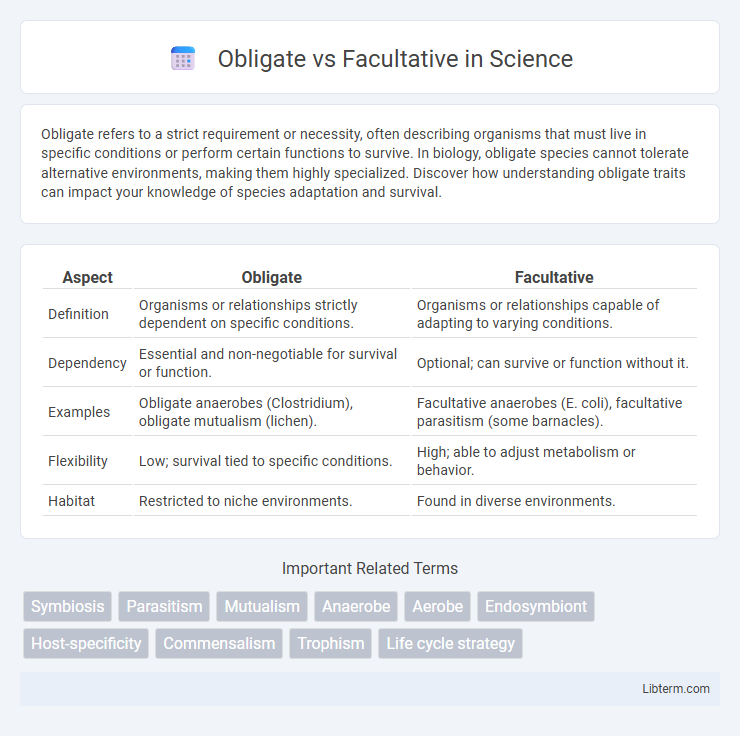Obligate refers to a strict requirement or necessity, often describing organisms that must live in specific conditions or perform certain functions to survive. In biology, obligate species cannot tolerate alternative environments, making them highly specialized. Discover how understanding obligate traits can impact your knowledge of species adaptation and survival.
Table of Comparison
| Aspect | Obligate | Facultative |
|---|---|---|
| Definition | Organisms or relationships strictly dependent on specific conditions. | Organisms or relationships capable of adapting to varying conditions. |
| Dependency | Essential and non-negotiable for survival or function. | Optional; can survive or function without it. |
| Examples | Obligate anaerobes (Clostridium), obligate mutualism (lichen). | Facultative anaerobes (E. coli), facultative parasitism (some barnacles). |
| Flexibility | Low; survival tied to specific conditions. | High; able to adjust metabolism or behavior. |
| Habitat | Restricted to niche environments. | Found in diverse environments. |
Introduction to Obligate and Facultative
Obligate organisms require specific environmental conditions or resources to survive, such as obligate aerobes needing oxygen to grow. Facultative organisms can adapt to a range of environmental conditions, thriving with or without particular factors like facultative anaerobes that utilize oxygen but can also survive in its absence. Understanding the distinction between obligate and facultative adaptation is essential in microbiology, ecology, and evolutionary biology for classifying species and predicting their responses to environmental changes.
Defining Obligate: Core Characteristics
Obligate organisms require specific environmental conditions or resources to survive, such as obligate aerobes needing oxygen for metabolism or obligate parasites depending entirely on a host for reproduction. These core characteristics include strict dependency on a single factor, limited metabolic flexibility, and inability to adapt beyond their essential biological requirements. Understanding obligate traits aids in distinguishing these species from facultative organisms, which possess greater environmental adaptability.
What Does Facultative Mean?
Facultative refers to organisms or behaviors that have the flexibility to adapt to different environmental conditions or lifestyles, allowing survival with or without specific factors. Unlike obligate organisms that require a certain condition to thrive, facultative organisms can function effectively whether the condition is present or absent. This adaptability provides ecological advantages by enabling facultative species to exploit diverse habitats and resources.
Key Differences Between Obligate and Facultative
Obligate organisms require specific environmental conditions or resources to survive, such as an obligate aerobe depending entirely on oxygen for respiration. Facultative organisms exhibit metabolic flexibility, enabling them to adapt to varying conditions by switching between modes, like facultative anaerobes that can grow with or without oxygen. The key difference lies in obligates' strict dependence on particular factors versus facultatives' ability to thrive under diverse circumstances.
Real-World Examples of Obligate Organisms
Obligate organisms require specific environmental conditions or relationships to survive, such as obligate aerobes like Mycobacterium tuberculosis that must have oxygen for growth. Obligate anaerobes like Clostridium botulinum cannot tolerate oxygen and thrive in oxygen-free environments. Obligate parasites, exemplified by Plasmodium species causing malaria, depend entirely on a host for their life cycle completion.
Facultative Organisms: Examples and Adaptations
Facultative organisms, such as facultative anaerobes like Escherichia coli and facultative parasites like certain amoebae, can survive in diverse environmental conditions by switching between aerobic and anaerobic metabolism or alternating between free-living and parasitic lifestyles. These organisms exhibit adaptive mechanisms including metabolic flexibility, which allows them to utilize oxygen when available or shift to fermentation in its absence, enhancing their survival across fluctuating habitats. This metabolic versatility and ecological adaptability enable facultative organisms to occupy varied ecological niches and respond dynamically to environmental stresses.
Ecological Roles: Obligate vs Facultative Species
Obligate species depend exclusively on specific environmental conditions or interactions for survival, such as obligate mutualists that require their partners to complete life cycles. Facultative species exhibit flexibility by surviving in varied conditions and engaging with multiple partners, allowing adaptability in changing ecosystems. This distinction influences ecological dynamics, with obligate species often shaping niche specialization, while facultative species contribute to ecosystem resilience and stability.
Impacts on Ecosystem Dynamics
Obligate species, such as corals with their symbiotic algae, depend exclusively on specific interactions, making ecosystems vulnerable to disruptions when these relationships break down. Facultative species, like cleaner fish, exhibit flexible interactions that can enhance ecosystem resilience by adapting to changing conditions and available partners. The balance between obligate and facultative species ultimately shapes biodiversity, nutrient cycling, and stability within ecological communities.
Evolutionary Significance and Adaptability
Obligate organisms exhibit strict dependence on specific environmental conditions or relationships, which limits their adaptability but ensures specialized survival strategies shaped by evolutionary pressures. Facultative organisms possess flexible survival mechanisms, allowing them to thrive across diverse environments and exhibit greater evolutionary adaptability through phenotypic plasticity. The contrast between obligate and facultative traits highlights evolutionary trade-offs between specialization and versatility, influencing species' resilience to changing ecosystems and environmental challenges.
Summary Table: Obligate vs Facultative Comparison
Obligate organisms require specific environmental conditions or resources to survive, such as obligate aerobes needing oxygen, while facultative organisms can adapt to varying conditions, like facultative anaerobes that switch between aerobic and anaerobic respiration. The summary table comparing obligate vs facultative highlights critical differences including dependency on environmental factors, metabolic flexibility, and survival strategies. Key distinctions in physiology and ecological roles define obligates as specialists and facultatives as generalists adaptable to fluctuating habitats.
Obligate Infographic

 libterm.com
libterm.com